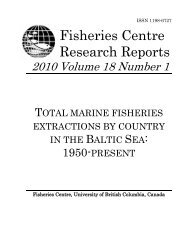Trends in GlobAl MArine Fisheries - Sea Around Us Project
Trends in GlobAl MArine Fisheries - Sea Around Us Project
Trends in GlobAl MArine Fisheries - Sea Around Us Project
Create successful ePaper yourself
Turn your PDF publications into a flip-book with our unique Google optimized e-Paper software.
ardized to have a value of zero <strong>in</strong> 1950.<br />
Figure 5 (based on Pauly et al. 2008) presents<br />
the MTI and FiB <strong>in</strong>dex for 53 LMEs comb<strong>in</strong>ed,<br />
but with two groups of fishes excluded: Peruvian<br />
anchoveta (Engraulis r<strong>in</strong>gens) and large pelagic<br />
fishes (large tunas and billfishes). The very localized<br />
South American fishery for Peruvian<br />
anchoveta, which is a low trophic level species, is<br />
the largest s<strong>in</strong>gle-species fishery <strong>in</strong> the world, and<br />
it exhibits very large fluctuations <strong>in</strong> catches (see<br />
Figure 1). This extreme variation masks the comparatively<br />
more subtle patterns <strong>in</strong> trophic level<br />
changes by the other fisheries of the world. We<br />
excluded large tunas and billfishes because much<br />
of their catch is taken <strong>in</strong> pelagic waters outside<br />
of the currently def<strong>in</strong>ed LMEs. Thus, <strong>in</strong>clud<strong>in</strong>g<br />
these land<strong>in</strong>gs from only part of their stockexploitation<br />
ranges would<br />
Figure 5. Two <strong>in</strong>dicators based on<br />
the trophic levels (TL) of exploited<br />
fish, here used to characterize the<br />
fisheries <strong>in</strong> all LMEs of the world<br />
comb<strong>in</strong>ed. Top: Mar<strong>in</strong>e Trophic<br />
Index (MTI), be<strong>in</strong>g the trend of mean<br />
TLs; and bottom: correspond<strong>in</strong>g<br />
trend of the Fish<strong>in</strong>g-<strong>in</strong>-Balance (FiB)<br />
<strong>in</strong>dex, which is def<strong>in</strong>ed such that its<br />
<strong>in</strong>crease <strong>in</strong> the face of stagnat<strong>in</strong>g<br />
or <strong>in</strong>creas<strong>in</strong>g MTI suggests a geographic<br />
expansion of the fisheries.<br />
<strong>Trends</strong> <strong>in</strong> global mar<strong>in</strong>e fisheries – a critical view<br />
Trophic level<br />
FiB Index<br />
3.5<br />
3.4<br />
3.3<br />
3.2<br />
3.1<br />
1950 1960 1970 1980 1990 2000<br />
0.6<br />
0.5<br />
0.4<br />
0.3<br />
0.2<br />
0.1<br />
artificially <strong>in</strong>flate patterns of trophic levels, especially<br />
for recent decade, when tuna fisheries<br />
expanded substantially (Pauly and Palomares<br />
2005). The trend <strong>in</strong> MTI for all LMEs comb<strong>in</strong>ed<br />
(Figure 5, top) <strong>in</strong>dicates a decl<strong>in</strong>e from<br />
a peak <strong>in</strong> the 1950s to a low <strong>in</strong> the mid 1980s.<br />
This can be attributed to ‘fish<strong>in</strong>g down mar<strong>in</strong>e<br />
food webs’ (Pauly et al. 1998a, Pauly and Watson<br />
2005), partly masked by an offshore expansion of<br />
the fisheries as <strong>in</strong>dicated by the <strong>in</strong>creas<strong>in</strong>g FiB<br />
<strong>in</strong>dex (Figure 5, bottom). In the mid 1980s, the<br />
cont<strong>in</strong>ued offshore expansion, comb<strong>in</strong>ed with decl<strong>in</strong><strong>in</strong>g<br />
<strong>in</strong>shore catches has resulted <strong>in</strong> a trend reversal<br />
<strong>in</strong> the MTI, i.e. to the fish<strong>in</strong>g down effect<br />
be<strong>in</strong>g completely occulted. Analyses at smaller<br />
scales (e.g., at the level of <strong>in</strong>dividual LMEs, see<br />
Sherman and Hempel 2008) confirm this.<br />
0<br />
1950 1960 1970 1980 1990 2000<br />
Year<br />
67





![Nacion.com, San José, Costa Rica [Nacionales] - Sea Around Us ...](https://img.yumpu.com/26166123/1/190x245/nacioncom-san-josac-costa-rica-nacionales-sea-around-us-.jpg?quality=85)










